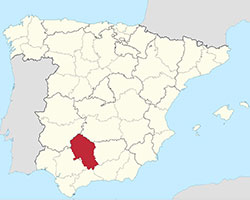Córdoba in Córdoba
 Córdoba is one of Andalusia’s eight provinces. It shares borders with the provinces of Málaga, Seville, Badajoz, Ciudad Real, Jaén and Granada.
Córdoba is one of Andalusia’s eight provinces. It shares borders with the provinces of Málaga, Seville, Badajoz, Ciudad Real, Jaén and Granada.
The province covers 13,769 m2 and has 788,219 (2017) inhabitants, more than 40% of which live in the capital of the same name.
A royal decree of November 30, 1833 created the Province of Córdoba (along with 48 other provinces), which was formed by joining the towns of the Kingdom of Córdoba and the following places in Extremadura: Belalcazar Fuente la Lancha, Hinojosa del Duque and Villanueva del Duque. The province is mainly divided into three geographical areas: the Sierra Morena to the north, the Baetic Depression in the center and La Campiña in the south.
The province of Cordoba is the 11th in Spain where the entire population is concentrated in the capital. On an average 31.96% of a Spanish province's population inhabits its capital. The province consists of 75 municipalities. They are further grouped into 8 “comarcas”.
 The province of Córdoba is divided into three main geographical areas: The Sierra Morena mountain range to the north, the Guadalquivir valley in the middle, and the Sierras Subbéticas to the south. The river Guadalquivir crosses the province from east to west, fed by numerous streams flowing down from the Sierra Morena, some of them small rivers in their own right, others seasonal, created by autumn and winter rainfall. The highest point in Córdoba is Pico de la Tiflosa in the Subbéticas mountain range at 1,568 m above sea level.
The province of Córdoba is divided into three main geographical areas: The Sierra Morena mountain range to the north, the Guadalquivir valley in the middle, and the Sierras Subbéticas to the south. The river Guadalquivir crosses the province from east to west, fed by numerous streams flowing down from the Sierra Morena, some of them small rivers in their own right, others seasonal, created by autumn and winter rainfall. The highest point in Córdoba is Pico de la Tiflosa in the Subbéticas mountain range at 1,568 m above sea level.
The climate is continental Mediterranean with temperatures in the capital ranging from 9.2 °C in January and 27.2 °C in July and August, which often exceed 40 °C. Rainfall in the capital is recorded from 600 to 750 mm per year. It is concentrated from October to April.
The City
The capital Córdoba has 325,916 inhabitants (2018) and is the third largest capital of Andalusia, and the 12th largest city of Spain. The Rio Guadalquivir runs right through the city and is crossed by several bridges from all periods of history, from Roman times up until today.
Córdoba is probably mainly known for its Mosque-Cathedral (La Mezquita de Córdoba which was built using pillars of uneven heights) and for the annual patio festival, when Córdoba’s beautiful courtyards with their abundance of colourful flowers are opened to the public, who crowd the city in their tens of thousands to experience this very special festival.
But that, of course, is the Córdoba of the 3rd millennium.
In the 1st millennium Córdoba came close to being almost the centre of the universe. Being founded in 169 A.D. by the Romans, the city soon became the capital of the ‘Provincia Hispania Ulterior Baetica’. It became a city of numerous recreational buildings and was home to prominent philosophers, poets and orators.
The city was conquered by the Moors in approximately 715, and from then on went from strength to strength. It became the capital of the Independent Emirate and the Western Omeya Caliphate. The number of inhabitants grew to more than 250,000 and by the 10th century it was one of the largest cities in the world as well as being the cultural, political and financial centre of the Iberian Peninsula.
Furthermore, the city had a famous university and a public library which had some 400,000 volumes. There were 27 free schools for poor children and the level of literacy was high amongst children of both sexes.
The city was adorned by countless gardens, waterfalls and artificial lakes, and by means of an aqueduct fresh water in abundance was supplied to fountains and public baths.
Sadly, Cordoba’s decline started shortly after that, upon the death in 1002 of Almanzor, ruler of Al Andalus for 24 years. This was the beginning of the end of Muslim rule on the Iberian Peninsula and of Córdoba’s importance in the Muslim world.
Many of the buildings from both Roman and Muslim rule are still in existence, either restored or ruins thereof and Córdoba’s historic centre is the second largest in Europe, the largest urban area in the world to have been granted the World Heritage status by UNESCO.
The Córdoba summers are scorching hot with temperatures often exceeding 40°C in the daytime and the average temperature for July and August at about 2 8°C. The annual rainfall is usually about 600mm and falls almost exclusively in the cooler months.
With its numerous monuments and sights, beautiful river and bridges and famous cuisine, tourism and the service sector connected with it, obviously make up an important part of Córdoba’s economy.
However, jewellery industry has had an important role in Córdoba since the 16th century, and it plays a very large part in the export sector. Córdoba is the third largest jewellery exporter in Spain and the largest in Andalusia, with a turnover of more than 100 million euro a year.
The University of Córdoba was founded in 1972. and the city was declared a world heritage site in 1984.


